In our show for Paul Roehl this fall, we featured this painting, an oil on canvas called “Acheron” (24″ x 48″). But it wasn’t framed—unless you regard as a frame the pine lattice that painters wisely attach to the edges of their stretched canvases to protect the vulnerable fabric edges. Those strips are justifiable in serving the first and most important function of a frame: to protect the picture. But there is much else we require of frames; on that below. 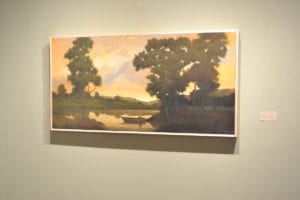 In any case, I became enchanted by this work, and decided that for Beloved California V we’d do it justice by having Trevor Davis design and make a proper frame for it.
In any case, I became enchanted by this work, and decided that for Beloved California V we’d do it justice by having Trevor Davis design and make a proper frame for it.
You can compare “Acheron” here at right, shown “before” in the minimal strip frame, with the “after,” below, in our wider, more substantial frame. The comparison illustrates pretty well the transformative effect of what we might call, to distinguish it from mere slats, an architectural frame on a picture.
The Frame
The frame is a cassetta in stained quartersawn white oak. The profile is 4-1/4″ wide on the top and bottom and 1/2″ wider on the sides, thus enhancing the strongly horizontal proportions. The difference in width is in the flat, which has mortise-and-tenon joints. The inner and outer mitered moldings, both carved (in contrast to the smooth flat), also echo each other in their cushion form canting in toward the painting. The back of the cap is cut in with a deep cove which sweeps outward, projecting beyond the outside of the cap’s face. Scroll down to see a gallery of photos of Trevor making the frame, and Sam finishing it.
Protection and Prospect—
 Comparing the effect of “Acheron” unframed to its effect in a substantial architectural frame illustrates not only the most satisfying reward of framing, but the most important lesson I’ve learned about the art of the frame. And it’s a lesson I got from the painter of “Acheron,” Paul Roehl. In a lecture Paul gave at the gallery in February 2017 called “Beyond Representation: The Poetic Landscape,” Professor Roehl (who’s long taught Art History at DeAnza College) explained a concept called “protection and prospect.” He described this idea as a compositional device landscape painters have often used, arranging the picture’s perspective to include a place of relative safety and shelter in the foreground (suggesting where the viewer is), against a wider and more wild and rugged distant land beyond. This arrangement seems to evoke a visceral effect in the viewer, tapping into two complementary primal human needs: security in our own particular place in the world—”protection“—along with a more comprehensive view of things and the sense of life’s possibilities—”prospect.” After writing about it in a blog post here, I followed up with the post here, on my epiphany when applying “protection and prospect” to not just the picture but its immediate architectural setting, the frame, to finally grasp the reason for that magical, transformational effect the right frame—a suitably architectural frame—has on the picture.
Comparing the effect of “Acheron” unframed to its effect in a substantial architectural frame illustrates not only the most satisfying reward of framing, but the most important lesson I’ve learned about the art of the frame. And it’s a lesson I got from the painter of “Acheron,” Paul Roehl. In a lecture Paul gave at the gallery in February 2017 called “Beyond Representation: The Poetic Landscape,” Professor Roehl (who’s long taught Art History at DeAnza College) explained a concept called “protection and prospect.” He described this idea as a compositional device landscape painters have often used, arranging the picture’s perspective to include a place of relative safety and shelter in the foreground (suggesting where the viewer is), against a wider and more wild and rugged distant land beyond. This arrangement seems to evoke a visceral effect in the viewer, tapping into two complementary primal human needs: security in our own particular place in the world—”protection“—along with a more comprehensive view of things and the sense of life’s possibilities—”prospect.” After writing about it in a blog post here, I followed up with the post here, on my epiphany when applying “protection and prospect” to not just the picture but its immediate architectural setting, the frame, to finally grasp the reason for that magical, transformational effect the right frame—a suitably architectural frame—has on the picture.
For all my years in framing, the true nature of that effect—that great reward for my work—had remained a mystery to me. I owe Paul a debt of gratitude for the key to solving that mystery.
Other Works by Paul Roehl included in Beloved California V—
-
“Overcast, “oil on canvas, 20″ x 24”.
$5,000 framed.
BUY
-
Paul Roehl “Berry Picker”
2020. Oil on panel, 8″ x 10″. SOLD.
-
Paul Roehl
“Looking East”
Oil on panel, 8″ x 10″.
$1,275 framed.
BUY
-
Paul Roehl “Solitary Walk V”
oil on panel, 8″ x 10″. SOLD
Process photos of Trevor Davis’s frame for “Acheron”—
- Sketch of the profile.
- Measure twice…
- …cut once!
- Edge jointing.
- Ripping on the table saw.
- The flat.
- Inner molding is splined.
- The slip is lap-joined.
- Flat, inner molding and slip are done.
- Trevor lays out the cap molding.
- Carving the cap molding.
- While joining the cap molding in the vise, Trevor cleans up the carving at the corners.
- Cap molding is splined.
- After the splines are dry, Trevor carves them down.
- The whole frame ready for final sanding.
- Sam stains the frame.
- Sam varnishes.
See Beloved California V online…
Go to Paul’s page to see more of his work…
Learn more about Paul and watch a recent video of the artist in his studio talking about his work…
« Back to Blog
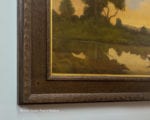













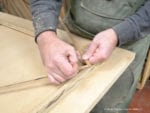




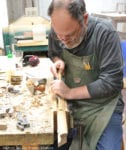







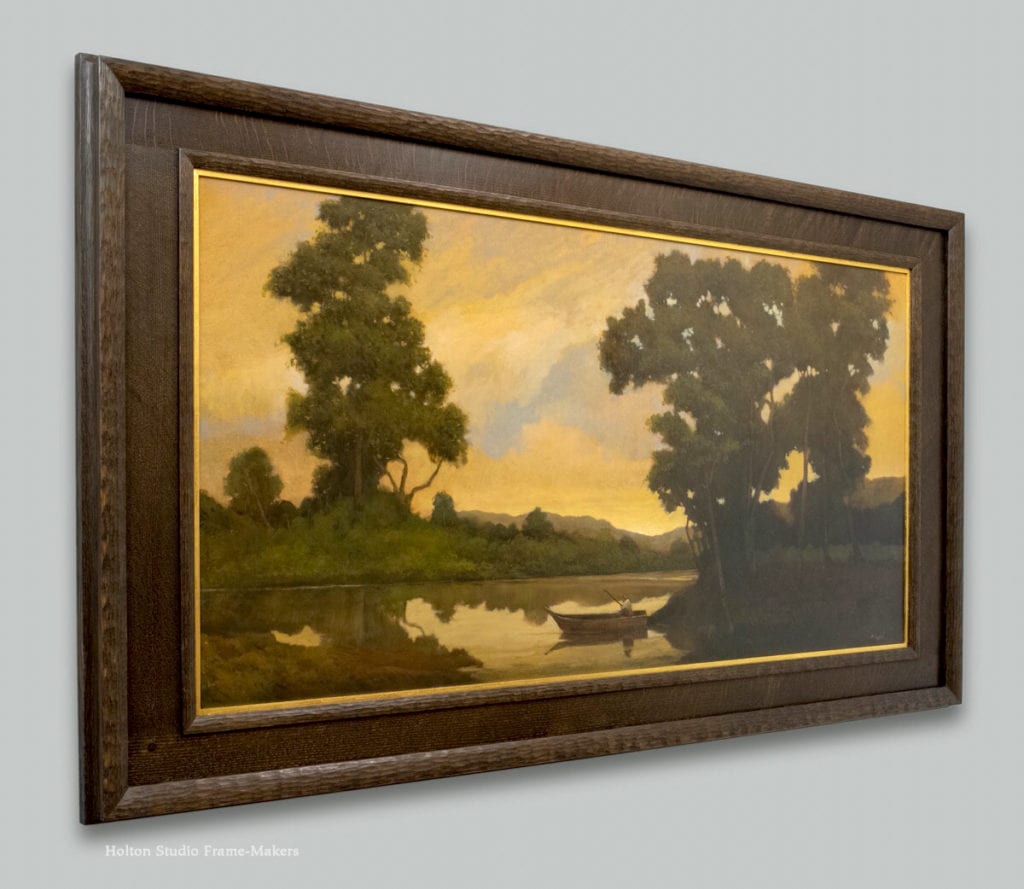
I love the interplay of protection and prospect. It will inform my preaching. Particularly with a transformative sermon, you want to protect and stabilize a person where they are. But then you want to take them on a transformational journey. You invite them into a distant prospect where they are changed or deepened. Then you gradually bring them back to the frame, stable again, but seeing the rest of the world differently because of what they’ve experienced.
I suppose the artist is God and the framer is the preacher.
Intriguing insight, Steve! Much more of that idea for me to plumb, so love to get perspectives!